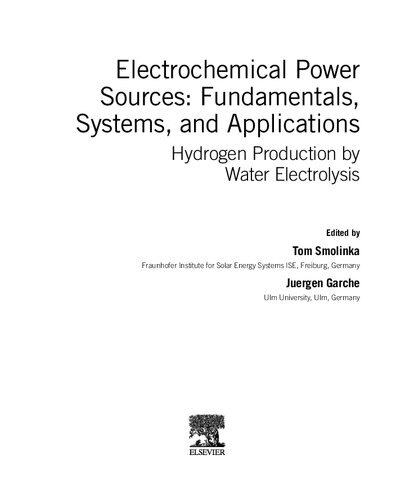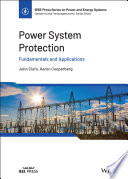Electrochemical power sources fundamentals systems and applications hydrogen production by water electrolysis 1st Edition by Tom Smolinka, Jürgen Garche ISBN 9780128194256 0128194251
$50.00 Original price was: $50.00.$25.00Current price is: $25.00.
Electrochemical power sources fundamentals systems and applications hydrogen production by water electrolysis 1st Edition by Tom Smolinka, Jürgen Garche – Ebook PDF Instant Download/Delivery: 9780128194256 ,0128194251
Full download Electrochemical power sources fundamentals systems and applications hydrogen production by water electrolysis 1st Edition after payment
Product details:
ISBN 10: 0128194251
ISBN 13: 9780128194256
Author: Tom Smolinka, Jürgen Garche
Electrochemical Power Sources: Fundamentals, Systems, and Applications: Hydrogen Production by Water Electrolysis offers a comprehensive overview about different hydrogen production technologies, including their technical features, development stage, recent advances, and technical and economic issues of system integration. Allied processes such as regenerative fuel cells and sea water electrolysis are also covered. For many years hydrogen production by water electrolysis was of minor importance, but research and development in the field has increased significantly in recent years, and a comprehensive overview is missing. This book bridges this gap and provides a general reference to the topic.
Hydrogen production by water electrolysis is the main technology to integrate high shares of electricity from renewable energy sources and balance out the supply and demand match in the energy system. Different electrochemical approaches exist to produce hydrogen from RES (Renewable Energy Sources).
- Covers the fundamentals of hydrogen production by water electrolysis
- Reviews all relevant technologies comprehensively
- Outlines important technical and economic issues of system integration
- Includes commercial examples and demonstrates electrolyzer projects
Electrochemical power sources fundamentals systems and applications hydrogen production by water electrolysis 1st Edition Table of contents:
Chapter 1 The importance of water electrolysis for our future energy system
Abstract
Chapter Outline
1.1 Introduction
1.2 Motivation and key drivers for hydrogen in the future energy system
1.3 Hydrogen in global energy future scenarios
1.4 Water electrolysis in a net-zero future
1.5 Summary and outlook to 2030
Abbreviations, terminology, units and conversions
References
Chapter 2 Fundamentals of water electrolysis
Abstract
Chapter Outline
2.1 Introduction
2.2 The water electrolysis cell
2.3 Thermodynamics
2.4 Non-equilibrium thermodynamics
2.5 Cell efficiencies
2.6 Conclusions
Glossary
References
Chapter 3 Thermochemical hydrogen processes
Abstract
Chapter Outline
3.1 Introduction
3.2 Metal oxide water splitting cycles
3.3 Copper–chlorine process
3.4 Sulfur-based process
3.5 Conclusions and outlook
References
Chapter 4 The history of water electrolysis from its beginnings to the present
Abstract
Chapter Outline
4.1 Introduction
4.2 First developments
4.3 Preindustrial time up to about 1900
4.4 Alkaline water electrolysis in the 20th century
4.5 History of polymer electrolyte membrane water electrolysis
4.6 History of high-temperature steam electrolysis
4.7 Recent past with focus on new markets for renewables energies
References
Chapter 5 Alkaline electrolysis—status and prospects
Abstract
Chapter Outline
5.1 Brief history of water electrolysis
5.2 Physical and chemical principles of electrolysis
5.3 Principle of operation of an alkaline electrolyzer
5.4 Technical concepts of electrolysis—status and prospects
5.5 Materials
5.6 Degradation effects in alkaline electrolyzers
5.7 Anion exchange membrane electrolysis
5.8 Description of technical plants
5.9 Alkaline electrolysis—future prospects
References
Chapter 6 PEM water electrolysis
Abstract
Chapter Outline
6.1 General principle and cell layout
6.2 Cell and stack materials
6.3 Performance on cell and system level
6.4 Degradation mechanisms and lifetime
6.5 Electrolyte
6.6 System aspects and operational experience
6.7 System configuration and design
6.8 Modeling of polymer electrolyte membrane or proton exchange membrane electrolyzers
6.9 Material level
6.10 Cell level
6.11 Stack and system level
6.12 Cost reduction potential of polymer electrolyte membrane or proton exchange membrane electrolyzers
6.13 Cost breakdown
6.14 Main actors and highlights of recent years
6.15 Outlook and new concepts
References
Chapter 7 High temperature steam electrolysis
Abstract
Chapter Outline
7.1 Introduction and general principle
7.2 Architecture of solid oxide cells
7.3 Cell materials
7.4 Stack components and designs
7.5 Cell performance
7.6 Stack performance
7.7 Structural analysis of cells and stacks
7.8 High temperature steam electrolyzer system
7.9 From cell to system cost analysis
7.10 Summary and outlook on future development
References
Chapter 8 Chlor–alkali electrolysis
Abstract
Chapter Outline
8.1 Introduction
8.2 Brief history of the chlor–alkali industry
8.3 Overview of chlor–alkali technologies
8.4 Materials and electrochemistry of a membrane cell
8.5 System configuration of membrane cell
8.6 Overview of the chlor–alkali industry with membrane cells
8.7 Future outlook and a new cathode concept
Acknowledgments
References
Chapter 9 Seawater electrolysis
Abstract
Chapter Outline
9.1 Introduction
9.2 Seawater electrolysis
9.3 Chlorine-free seawater electrolysis for hydrogen production
9.4 Summary
References
Chapter 10 Economic considerations for hydrogen production with a focus on polymer electrolyte membrane electrolysis
Abstract
Chapter Outline
10.1 Introduction
10.2 Background
10.3 Hydrogen markets
10.4 Hydrogen production cost economic considerations
10.5 Basic hydrogen economics (100 level)
10.6 Hydrogen economics (300 level)
10.7 Advanced hydrogen economics (500 level)
10.8 Assumptions and knowledge gaps
10.9 Summary
Funding sources
Acknowledgments
References
Chapter 11 Regenerative fuel cells
Abstract
Chapter Outline
11.1 Introduction
11.2 Regenerative fuel cells based on proton exchange membranes technology
11.3 Other unitized regenerative fuel cell systems
11.4 Applications
11.5 Outline
References
Chapter 12 New electrolyzer principles: decoupled water splitting
Abstract
Chapter Outline
12.1 Introductions
12.2 Electrolytic schemes for decoupled water splitting
12.3 Electrochemical–chemical cycles for decoupled water splitting
12.4 Decoupled photoelectrochemical and photocatalytic water splitting
12.5 Summary
Acknowledgment
Competing interests
References
Chapter 13 Hydrogen storage
Abstract
Chapter Outline
13.1 Introduction
13.2 Physical storage
13.3 Adsorption storage
13.4 Chemical hydrogen storage
13.5 Comparison of different storage technologies
13.6 Large-scale and underground hydrogen storage
13.7 Storage for mobile applications
13.8 Summary
13.9 Suggestions for further reading
References
Index
People also search for Electrochemical power sources fundamentals systems and applications hydrogen production by water electrolysis 1st Edition:
encyclopedia of electrochemical power sources 2nd edition
asian conference on electrochemical power sources 2024
modern batteries an introduction to electrochemical power sources
encyclopedia of electrochemical power sources abbreviation
asian conference on electrochemical power sources 12
Tags: Tom Smolinka, Jürgen Garche, Electrochemical power sources, hydrogen production, water electrolysis
You may also like…
Medicine - Radiology
Medical Imaging Methods: Theory and Applications 1st Edition Edited By Ashutosh Kumar Shukla
Medicine - Cardiology
Medicine - Others
Computers - Computer Science
Uncategorized
Engineering - Electrical & Electronic Engineering
Education Studies & Teaching - Studying & Test Preparation












